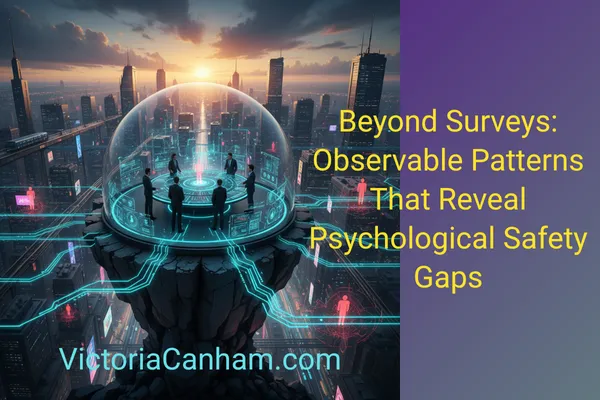Beyond Surveys: Observable Patterns That Reveal Psychological Safety Gaps
Victoria Canham • 19 November 2025 • 8 min read

"A shared belief held by members of a team that the team is safe for interpersonal risk-taking."
- Amy Edmondson
In my previous articles 1, 2, 3 , we've explored what psychological safety means, why it matters in business terms, and the four cornerstone framework for building it. Now comes the practical question: How do you know where psychological safety is breaking down in your organisation?
Most organisations reach for surveys. Anonymous questionnaires. Engagement scores. Pulse checks.
These aren't useless, but they have significant limitations:
They tell you there's a problem, but rarely where it's coming from. They capture perceptions at a single point in time, not the ongoing patterns that create or destroy safety. They can be gamed, either consciously (people giving answers they think are expected) or unconsciously (people not recognising their own adaptation to an unsafe culture).
After years of culture transformation work, I've learned that the most reliable diagnostic isn't what people say on surveys. It's what you observe them actually doing.
Psychological safety, or its absence, shows up in behavioural patterns. Once you know what to look for, these patterns become visible everywhere: in meetings, in how information flows, in how decisions are made, in what people don't say as much as what they do.
This article is your field guide to spotting where safety is breaking down, which of the four cornerstones needs attention, and what the patterns mean.
The Seven Observable Patterns of Low Psychological Safety
Pattern 1: The Silence After Questions
What it looks like:
A leader asks a question in a meeting. There's a pause. No one responds immediately. The silence becomes uncomfortable. Eventually, either the leader answers their own question or the most senior person in the room offers a safe, agreeable response.
This pattern repeats across multiple meetings and topics.
What it means:
People have learned that speaking up carries risk. They're calculating whether it's safe to answer honestly, waiting to see if someone else will go first, or hoping the moment will pass.
The silence is fear.
Which cornerstone is weak:
Primarily Leadership Foundation, people don't trust how leaders will respond to honest input. Often combined with Communication Culture, the norms haven't been established that make it safe to speak.
What to do:
Leaders need to explicitly name the pattern: "I'm noticing silence when I ask questions. That tells me something about how safe it feels to respond. What would make it easier to share your thinking?"
Then critically: respond well when someone does speak up, especially if they share something difficult.
Pattern 2: The Corridor Conversation
What it looks like:
The "real" meeting happens after the official meeting ends. People gather in small groups in corridors, offices, or messaging channels to say what they really think. The honest concerns, the disagreements, the "I can't believe we're doing this"; all of it happens outside the formal space.
What it means:
The official meeting wasn't safe enough for the truth. People are managing risk by keeping honest perspectives private and only sharing them with trusted colleagues.
This is organisational dysfunction masquerading as normal behaviour.
Which cornerstone is weak:
Communication Culture, the systems and norms for dialogue aren't working. Also, often Leadership Foundation, if leaders are present in those meetings and creating pressure to perform rather than problem-solve.
What to do:
Start calling out the pattern (gently): "I have a sense that the real conversation is happening after we leave this room. What would need to change for us to have those conversations here?"
Then redesign how meetings work; smaller groups, different facilitation, explicit invitation for dissent.
Pattern 3: The Hedged Question
What it looks like:
Someone asks a question but wraps it in extensive apologising and disclaiming:
"Sorry, this might be a stupid question..." "I'm probably missing something obvious, but..." "This might just be me, however..." "I don't want to slow us down, but..."
The question itself is often perfectly legitimate, but the hedging reveals the fear.
What it means:
People have learned that asking questions risks looking incompetent. They're trying to protect themselves from judgment by pre-emptively minimising their question.
The cognitive load of constructing these hedges repeatedly, across many interactions, is exhausting and diverts energy from actual thinking.
Which cornerstone is weak:
Learning Environment, it's not safe to not know things. Combined with Communication Culture norms that haven't made questions explicitly welcome.
What to do:
When you hear hedging, interrupt it positively: "No need to apologise, this is exactly the kind of question we need. Thank you for asking."
Model asking your own questions without hedging. Make it normal.
Pattern 4: The Disappeared Dissent
What it looks like:
In the early stages of a project or decision, there's visible disagreement and debate. As the decision moves up the hierarchy or gets closer to implementation, suddenly everyone appears aligned. Concerns that were raised earlier have vanished from the conversation.
Then the initiative struggles or fails, and those original concerns turn out to have been valid.
What it means:
Dissent hasn't been resolved; it's been suppressed. At some point, people learned that continuing to raise concerns was career-limiting, so they stopped doing so. But the concerns remain valid.
This is how organisations make catastrophic mistakes with full "consensus."
Which cornerstone is weak:
Leadership Foundation at senior levels; people don't feel safe escalating concerns. Often combined with Communication Culture, where there's no safe mechanism to flag ongoing concerns.
What to do:
Explicitly invite dissent at decision points: "What concerns aren't we voicing? What could go wrong that we're not discussing?"
Then, when someone does voice a concern, treat it seriously, even if you ultimately proceed anyway.
Pattern 5: The Mistake Vanishing Act
What it looks like:
When something goes wrong, it's minimised, explained away, or attributed to external factors beyond anyone's control. No one admits they made a mistake. No one takes responsibility. The conversation moves quickly to "let's focus on moving forward."
Post-mortems, if they happen at all, are exercises in blame diffusion rather than learning.
What it means:
Mistakes have consequences beyond learning. People have calculated that admitting error is riskier than deflecting, so that's what they do.
The organisational result is that the same mistakes repeat because no one genuinely examines what happened.
Which cornerstone is weak:
Learning Environment, it's not safe to fail or even acknowledge failure. This often stems from Leadership Foundation issues where leaders punish or shame mistakes.
What to do:
Leaders need to model admitting mistakes first. Publicly. Without excuse.
Then create structured opportunities to examine failures: "What did we learn? What would we do differently? What systemic factors contributed?"
Pattern 6: The Question Drought
What it looks like:
In presentations, training sessions, or information-sharing meetings, there's a call for questions. Silence. "Any questions?" More silence. "Great, let's move on."
However, afterwards, individually, people ask clarifying questions they didn't feel comfortable asking publicly.
What it means:
Asking questions in public feels risky. People fear looking stupid, slowing things down, or challenging the presenter's expertise.
The organisational cost is that confusion and misalignment persist because people don't get clarity in the moment.
Which cornerstone is weak:
Communication Culture and Learning Environment; questions aren't normalised and welcomed. Sometimes, Inclusive Belonging if certain groups feel less safe asking than others.
What to do:
Change how you invite questions. Instead of "Any questions?" try:
"What questions do you have?" (assumes questions exist) "What's unclear that would be helpful to discuss?" "What am I assuming everyone knows that we should clarify?"
Then pause longer. Wait through the discomfort.
Pattern 7: The Uneven Voice Distribution
What it looks like:
In meetings, the same people speak repeatedly while others remain silent. This pattern correlates with power (seniority, function, proximity to leadership) or majority identity (gender, race, background).
When quieter people do speak, they're interrupted more, their ideas get less traction, or their contributions are acknowledged less.
What it means:
Psychological safety isn't distributed equitably. Some people have learned that speaking up is riskier for them than for others, and they're often right.
This is both an inclusion problem and a performance problem, because you're not accessing everyone's thinking.
Which cornerstone is weak:
Inclusive Belonging primarily, but this interacts with all four cornerstones. Safety that only works for some people isn't real safety.
What to do:
Start tracking voice distribution explicitly. Notice who speaks, who doesn't, who gets interrupted, whose ideas gain traction.
Then actively create space: "We've heard from several people. I'd like to hear from others before we move forward. [Name], what's your perspective?"
Address interruptions and idea theft in the moment.
Connecting Patterns to Cornerstones
When you observe these patterns, you can diagnose which cornerstones need attention:
If you see Patterns 1, 2, 4, 5: Leadership Foundation is likely weak. Leaders' responses to challenge, bad news, and mistakes are creating fear rather than safety.
If you see Patterns 1, 2, 3, 6: Communication Culture needs work. The systems and norms for dialogue aren't enabling honest exchange.
If you see Patterns 3, 5, 6: Learning Environment is inadequate. It's not safe to not know, to question, or to fail.
If you see Pattern 7 (possibly combined with others): Inclusive Belonging is weak. Safety is working for some people, but not everyone.
Most organisations will see multiple patterns, indicating that several cornerstones need attention. That's normal. The question is: where do you start?
Beyond Observation: What to Listen For
Patterns aren't just behavioural—they show up in language too. Here's what to listen for:
Language that signals low safety:
🚩 "That's above my pay grade"
🚩 "I'm not sure I should say this, but..."
🚩 "Others might disagree, but..." (when no one has disagreed)
🚩 "I don't want to be negative, but..."
🚩 "That's just how things work here"
🚩 "Let's take this offline"
🚩 "I'll circle back on that" (when they won't)
Language that signals emerging safety:
✅ "I don't know" (without hedging)
✅ "I was wrong about that"
✅ "Here's what I'm worried about"
✅ "Can someone help me understand..."
✅ "I disagree because..."
✅ Direct questions without preamble
✅ Acknowledgement of failure without blame
Track the ratio of these language patterns over time. It's a reliable indicator of cultural direction.
The Diagnostic Questions to Ask Yourself
If you're trying to assess psychological safety in your team or organisation, ask:
About voice and contribution:
✳️ Who speaks freely in meetings and who stays quiet?
✳️ Whose ideas get traction and whose are dismissed?
✳️ Who asks questions and who pretends to understand?
About mistakes and learning:
✳️ When something goes wrong, what happens?
✳️ Do people admit mistakes voluntarily or only when caught?
✳️ Are failures examined for learning or swept away quickly?
About challenge and dissent:
✳️ When was the last time someone disagreed with me in a meeting?
✳️ Do concerns surface early or late?
✳️ What happened the last time someone challenged a decision?
About information flow:
✳️ Do I hear bad news directly or through intermediaries?
✳️ What gets discussed in official forums vs. private conversations?
✳️ Are questions asked openly or only in private?
About inclusion:
✳️ Is voice distributed equitably across the team?
✳️ Do people from different backgrounds contribute equally?
✳️ Are some people more careful than others about what they say?
Your honest answers to these questions will reveal where safety is breaking down.
What Surveys Miss (and Why Observation Matters More)
Surveys can tell you that trust is low or that people don't feel comfortable speaking up. But they can't tell you:
✳️ Which specific leader behaviours are creating fear?
✳️ What moments in your processes feel risky?
✳️ How have people adapted to unsafety in ways they don't even recognise?
✳️ What do the real-time dynamics look like?
✳️ Where the pattern started and how it's perpetuating
Observation gives you that granular, actionable insight.
The other advantage of observation: you can do it continuously. Surveys are snapshots. Patterns are ongoing. By training yourself and your leaders to observe these patterns, you create a continuous diagnostic capability.
The Self-Diagnosis Trap
One warning: leaders consistently overestimate psychological safety in their teams, which isn’t necessarily a result of malice or delusion. It's structural:
✳️ You have more power, so speaking up feels less risky to you
✳️ People manage what you see, showing you a safer version of reality
✳️ Your presence changes dynamics; meetings with you feel different from meetings without you
✳️ You may interpret politeness as safety
That's why patterns matter more than your perception. Watch what people do when they think you're not watching. Listen to what happens in meetings you're not in. Ask people you trust to tell you what they're observing.
The gap between your perception and reality is often where the biggest problems hide.
From Diagnosis to Action
Understanding these patterns is the first step. The next question is: what do you do about them?
That's what my final article addresses: specific, accessible approaches to building each of the four cornerstones without breaking the bank.
But diagnosis matters because generic solutions don't work. You need to know which cornerstones are weak, what specific patterns are showing up, and where to focus your energy.
Start observing this week. Pick one meeting and watch for these seven patterns. I guarantee you'll see at least three of them.
Once you see them, you can't unsee them.
And once you see them for all they are, you can start changing them.
Where We Are
We've now covered:
✳️ What psychological safety really means
✳️ Why it costs your organisation when it's absent
✳️ The four cornerstones for building it
✳️ How to diagnose where it's breaking down
Next and final article: the practical, accessible approaches to building psychological safety without massive budgets or external consultancies.
The barrier isn't the cost, but rather knowing where to focus and having the commitment to do the work.
This is Article 4 in a series on Psychological Safety in the Workplace.
Previous articles:
Article 1: "Psychological Safety: The Misunderstood Foundation of High Performance"
Article 2: "The Hidden Tax of Fear: Why Psychological Safety Is Your Greatest Performance Lever"
Article 3: "The Four Cornerstones of Psychological Safety: A Culture-First Framework"
Coming next in this series:
Article 5: Building Psychological Safety Without Breaking the Bank
More Articles About Psychological Safety:
This is Article 4 in a series on Psychological Safety in the Workplace. Follow along as we explore how to build cultures where people can do their best work.
♦️ Hi. I'm Vicki, and I help businesses build high-performing, loyal teams by mastering the employee journey. I partner with leaders to drive tangible change, transforming company culture from a pretty promise on a slide deck into a daily reality. My approach goes beyond outdated HR strategies and gets to the heart of what truly motivates and retains your people.
Here's how I can support you:
Consulting & Coaching
I work directly with business leaders to diagnose and transform their employee experience, from culture to performance management. If you're ready to stop the cycle of burnout and build a team that thrives, not just survives, let's talk.
Click here to book a free 30-minute strategy call. No fluff, no sales pitches, just a direct conversation about your biggest challenges.
Talks & Keynotes
I deliver engaging keynotes that go beyond theory to provide actionable insights on leadership, culture, and performance. My talks are perfect for leadership teams and conferences looking to inspire real change.
Workshops & Training
My bespoke workshops and training sessions are designed to equip your leaders with the practical tools they need to build, manage, and retain exceptional teams. These are highly interactive sessions focused on creating measurable improvements in your business.
👉 Book a Clarity & Culture Call
Follow me on LinkedIn for more insights on building high-performing teams in 2025.
Comment On This Article
Recommended Reading
Fast Asleep: How to get a really good night's rest by Dr Michael Mosley
A good night's sleep is essential for a healthy brain and body. So why do so many of us struggle to sleep well? In Fast Asleep, Dr Michael Mosley explains what happens when we sleep, what triggers common sleep problems and why standard advice rarely works.
Prone to insomnia, he has taken part in numerous sleep experiments and tested every remedy going. The result is a radical, four-week programme, based on the latest science, designed to help you re-establish a healthy sleep pattern in record time.
With plenty of surprising recommendations - including tips for teenagers, people working night shifts and those prone to jet lag - plus recipes which will boost your deep sleep by improving your gut microbiome, Fast Asleep provides the tools you need to sleep better, reduce stress and feel happier.
We’re not just about overcoming obstacles, we’re about transforming lives.
Book Recommendation

Victoria Canham - Performance and People Strategic Partner
Victoria Canham is an ICF-accredited Certified Professional Coach and the founder of Victoria Canham Consultancy. We are a specialist performance consultancy partnering with senior leaders and HR teams to elevate culture, leadership, and employee experience. Rooted in behavioural insight and change expertise, we diagnose what's truly holding performance back, co-creating practical, strategic interventions that drive sustainable business results and build workplaces that work—for people and performance.
Hang out with us on social media
SOCIAL FEED


💸 Your people don’t leave for money. 💣 They leave for culture. 🔧 I fix that. 🏆 Retention & performance strategy that works.
Book a ☎️ | Fix the Leaks
LET'S WORK TOGETHER
Book a call to find out how I can help you to achieve your peak performance.
© Copyright 2025 Victoria Canham Coaching | Website built by Me on FEA Create (aff.)
Performance Coaching Reading, London, Berkshire, Oxford | St George's Road, Reading, Berkshire, United Kingdom, RG30 2RL | +44 7377 527 529 | [email protected] Open Monday to Friday 9 am until 5 pm

 RSS Feed
RSS Feed